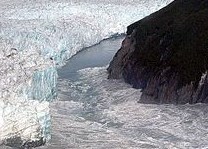Glacial Lake Outburst Floods (GLOFs)
Glacial Lake Outburst Floods (GLOFs) are disaster events caused by the abrupt discharge of water from glacial lakes — large bodies of water that sit in front of, on top of, or beneath a melting glacier. As a glacier withdraws, it leaves behind a depression that gets filled with meltwater, thereby forming a lake. The more the glacier recedes, the bigger and more dangerous the lake becomes. Such lakes are mostly dammed by unstable ice or sediment composed of loose rock and debris.
Triggering Factors and Impact of GLOFs
GLOFs can be triggered by various reasons, including glacial calving, where sizable ice chunks detach from the glacier into the lake, inducing sudden water displacement. Incidents such as avalanches or landslides can also impact the stability of the boundary around a glacial lake, leading to its failure, and the rapid discharge of water.
GLOFs can unleash large volumes of water, sediment, and debris downstream with formidable force and velocity. The floodwaters can submerge valleys, obliterate infrastructure such as roads, bridges, and buildings, and result in significant loss of life and livelihoods.
Rising Frequency of GLOFs
In recent years, there has been a rise in GLOF events in the Himalayan region as soaring global temperatures have increased glacier melting. Rapid infrastructure development in vulnerable areas has also contributed to the spike in such incidents.
Studies have shown that around 15 million people face the risk of sudden and deadly flooding from glacial lakes, which are expanding and rising in numbers due to global warming. In India and Pakistan alone, about 5 million people face the risk of GLOFs.
Potentially Hazardous Glacial Lakes
The National Disaster Management Authority (NDMA) has identified 188 glacial lakes in the Himalayan states that can potentially be breached because of heavy rainfall. Thirteen of them are in Uttarakhand. Rising surface temperatures across the globe, including India, have increased the risk of GLOFs.
GLOFs in Uttarakhand
GLOFs pose a significant threat to Uttarakhand. Uttarakhand has 13 glacial lakes which are prone to GLOFs. Five highly sensitive glacial lakes fall into the ‘A’ category, which means they are at the highest risk of breach. These include Vasudhara Tal in the Dhauliganga basin in Chamoli district, and four lakes in Pithoragarh district.
Uttarakhand has witnessed two major GLOF events in the past few years. The first took place in June 2013, which affected large parts of the state — Kedarnath valley was the worst hit, where thousands of people died. The second occurred in February 2021, when Chamoli district was hit by flash floods due to the bursting of a glacier lake.
In 2024 Uttarakhand government has constituted two teams of experts to evaluate the risk posed by five potentially hazardous glacial lakes in the region. The goal of the risk assessment exercise is to minimise the possibility of a GLOF incident and provide more time for relief and evacuation in case of a breach.


